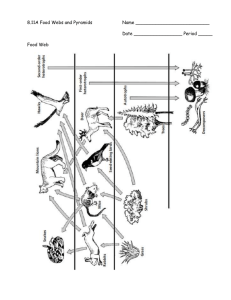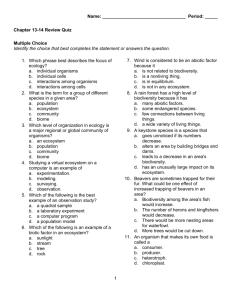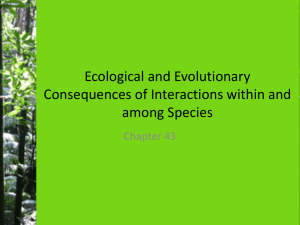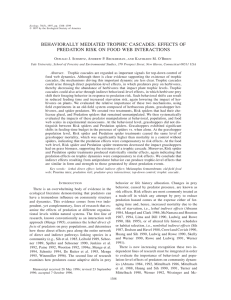Ecology/Relationships
advertisement
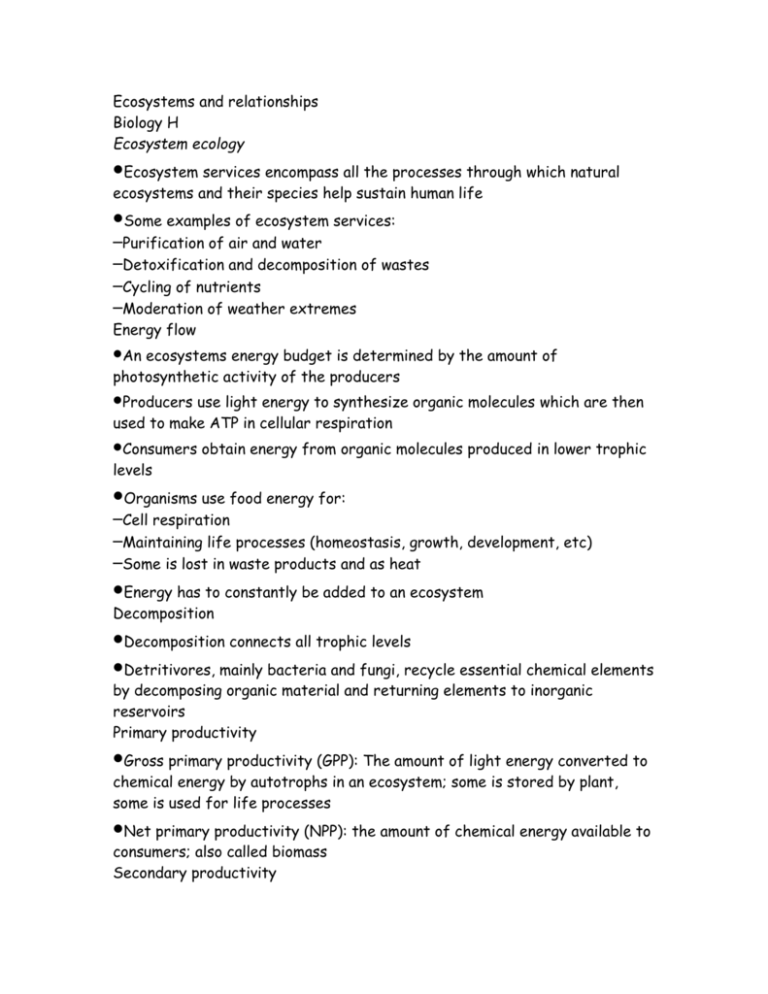
Ecosystems and relationships Biology H Ecosystem ecology •Ecosystem services encompass all the processes through which natural ecosystems and their species help sustain human life •Some examples of ecosystem services: –Purification of air and water –Detoxification and decomposition of wastes –Cycling of nutrients –Moderation of weather extremes Energy flow •An ecosystems energy budget is determined by the amount of photosynthetic activity of the producers •Producers use light energy to synthesize organic molecules which are then used to make ATP in cellular respiration •Consumers obtain energy from organic molecules produced in lower trophic levels •Organisms use food energy for: –Cell respiration –Maintaining life processes (homeostasis, growth, development, etc) –Some is lost in waste products and as heat •Energy has to constantly be added to an ecosystem Decomposition •Decomposition connects all trophic levels •Detritivores, mainly bacteria and fungi, recycle essential chemical elements by decomposing organic material and returning elements to inorganic reservoirs Primary productivity •Gross primary productivity (GPP): The amount of light energy converted to chemical energy by autotrophs in an ecosystem; some is stored by plant, some is used for life processes •Net primary productivity (NPP): the amount of chemical energy available to consumers; also called biomass Secondary productivity •Rate at which consumers convert the chemical energy in the food they eat to their own biomass –Consumers use energy for life functions but cannot completely digest the food so only about 10% of the energy consumed is available to the next trophic level –Pictured in a pyramid Types of pyramids •Pyramid of productivity (at trophic levels) •Biomass pyramid •Pyramid of numbers (individuals) •All are similar in that the bases are wide (lots of producers) and narrow greatly at the top (few top level consumers) and only have 3-5 trophic levels Community interactions •Ecologists call relationships between species in a community interspecific interactions •Interspecific interactions affect species survival and reproduction •Examples are competition, predation, herbivory, symbiosis (parasitism, mutualism, and commensalism), and disease •Competition: (-/-) –Interspecific: between species –Intraspecific: within a species –Interference: fighting over resources –Exploitative: use of resources –Resource partitioning: each species uses only a part of the resources which lessons competition Competition •Interspecific competition occurs when species compete for a resource in short supply •Strong competition can lead to competitive exclusion, local elimination of a competing species –The competitive exclusion principle states that two species competing for the same limiting resources cannot coexist in the same place Ecological Niches •The total of a species’ use of biotic and abiotic resources is called the species’ ecological niche •Similar species can coexist in a community if there are significant differences in their niches •As a result of competition, a species’ fundamental niche (all resources it’s capable of using) may differ from its realized niche (resources they actually use) Predation •Predation refers to interaction where one species, the predator, kills and eats the other, the prey •Some feeding adaptations of predators are claws, teeth, fangs, stingers, and poison •Prey display various defensive adaptations •Behavioral defenses include hiding, fleeing, self-defense, and alarm calls •Animals also have morphological and physiological defense adaptations Keystone predator •Helps maintain biodiversity by eating the best competitor at the next lowest trophic level •Examples •Sea stars in intertidal zones eat mussels which crowd out all other invertebrates •Sea otters in kelp forests eat sea urchins which eat through kelp holdfasts and allow the kelp forest to float away Mutualism Commensalism Defense against predation •Cryptic coloration: camouflage •Aposematic coloration: bright, warning coloration •Batesian mimicry: copy a toxic or dangerous animal Human Disturbance •Humans are the most widespread agents of disturbance •Human disturbance to communities usually reduces species diversity •Humans also prevent some naturally occurring disturbances, like fires, which can be important to community structure Four Major Threats to Biodiversity •Most species loss can be traced to four major threats: –Habitat destruction –Introduced species –Overexploitation –Disruption of “interaction networks”







